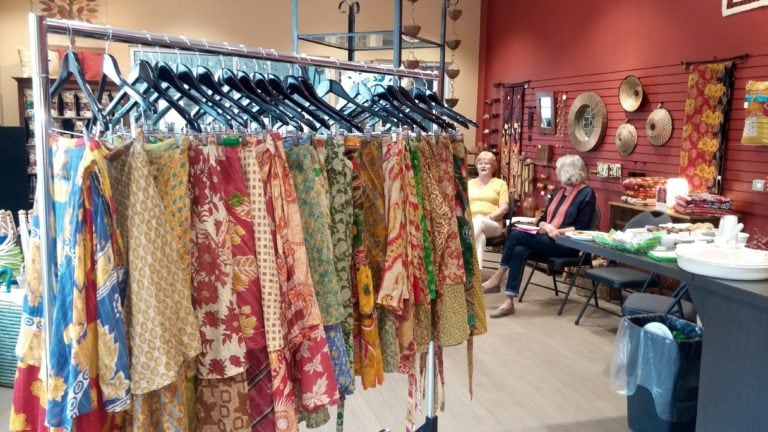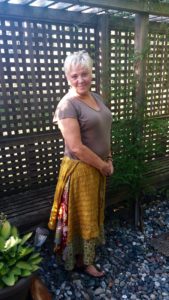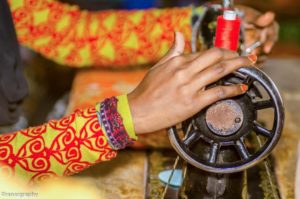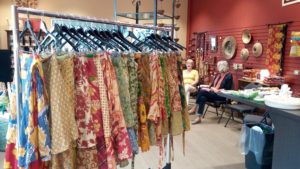Product development takes place in different way, including suggestions from consumers. Meg Gerbrandt-Weibe,Member of the Board of the Fraser Valley Mennonite Central Committee – Canada, recently shared with us her experience of developing a line of recycled sari skits with Sacred Mark Enterprise.
I grew up in a Mennonite Central Committee (MCC) family in Manitoba. My families’ history goes back to the very beginnings of MCC in North America in the early 1900’s when MCC helped refugees escaping from war in Russia and Europe, which is where my ancestors came from, the Ukraine area of Russia. My mother was among the founding members of MCC Thrift Stores which started in Altona, Manitoba in the 1940’s. Now MCC Thrift brings in millions of dollars annually for international relief and development work. My father was a long-standing board member for MCC Manitoba. I followed in his tradition by becoming a long-standing board member for MCC BC, followed by my current involvement on the board of Ten Thousand Villages, MCC’s fair trade arm, which imports fair trade product from 29 underdeveloped countries in the world. This work, with its focus on social justice fits my theology perfectly.
My involvement with Sacred Mark Enterprise (SME) came about a year ago when I visited Bangladesh as part of an MCC Learning tour. Although I was aware of SME through my board work at Ten Thousand Villages, and as a long time consumer of their products, it was the direct and intimate involvement in person that was the beginning of the sari skirt project. As I visited with the unit manager, Deepa and the women in the workshop, drinking chai, and chatting and admiring the work, we developed a bond that transcended international boundaries and distance.
When I was back home in Canada, I wore a non fair trade silk recycled sari skirt that I had purchased on a trip to Quebec City a few years ago. Every time I wear that skirt, I get many compliments and questions as to where the skirt can be purchased. I remembered that in a conversation with a member of the MCC staff that mentioned a challenge for small fair trade cooperatives is to find new products that appeal to the Western market. I began to think of the possibility of creating a cotton version of a sari skirt for sale in the Ten Thousand Villages shops and I reached out to both SME and MCC in Bangladesh, with my initial proposal.
I received an enthusiastic response from Deepa and MCC Bangladesh and as they felt that this was something that the women could be taught to make, and I was sure that the product had the potential to be a good seller in North America. In addition to this, I reached out to the director of Ten Thousand Villages, and asked for permission to proceed with exploring the sari skirt as a potential Villages product. While this sort of maverick project isn’t the norm, we did received permission to proceed as long as we followed very clear Villages guidelines.
SME made it clear that they could only source cotton saris, not silk and this was fine with me, as I had always thought that I’d actually prefer my skirt to be cotton anyway. Cotton would provide a more casual, light, summery look, that was easy to wash, and take along as a travelling skirt as well. The biggest challenge for SME was to find saris that were not overly worn, to the point that the fabric is compromised. Also, the Pacific Northwest coast colour aesthetics was a challenge for them as the preference tends to be for more subdued earth colours with greyish undertones vs. the Asian colour palette.
We are currently looking at a process of using natural, organic indigo to dye over the saris. Probitra, another project of MCC Bangladesh who are connected with Sacred Mark, are involved in trying to get a good, staying colour that is even and won’t wash out. They’re in the phases of developing the colours and and we’re waiting and watching with interest!
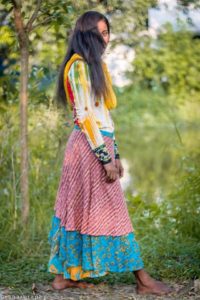
We planned to have the skirts arrive in Canada at our Villages shops by the beginning of June, so that we could present the skirts as a summer product. The skirts arrived exactly on time. We needed a few days to unpack them, steam them for wrinkles during shipping, and check for quality control. We were disappointed that 15 of the 60 skirts were of very poor quality. This involved fabric that was so worn or stained or had too many patches on it that we felt the quality was too compromised to sell to the public. Also, the sewing was very poor on some of those 15 skirts, with seams inside out and crookedly cut top and/or bottom layers. We personally did what repairs we could, but some were still not sellable.
Since this first order was a trail run, to see if the market in our Pacific Northwest Coast was interested, we wanted to keep advertising to a minimum. And in reality, we had no advertising budget to speak of. We launched the skirts by advertising through word of mouth, Facebook, and posters. One of the MCC staff, who is also a renowned amateur, award winning photographer, sent wonderful pictures of the production process, and some of the women of SME modelling the skirts. Then photos were wonderful – wild and bohemian! We made our own posters and wrote our own copy, which we posted on Facebook.
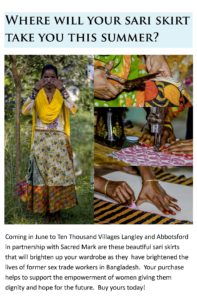
The women loved the skirts. several women bought multiple skirts, since each one was unique and different, for their own wardrobes, and some women bought skirts for their daughters and daughters in law. Other Villages shops from across Canada heard about our pilot project, and wrote to us indicating interest in participating. At this point, our head office reminded us that only our two board owned shops in Abbotsford and Canada had permission to proceed with the project. So we deferred any queries about ordering back to head office.
There was disappointment the next day with the general public as there were so few skirts left over after the opening event! We explained that this was a pilot, a trial run, and that if the skirts were well received, we’d immediately put in another order.
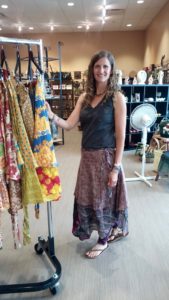
Language and cultural barriers with explaining the project were the first challenge. Fortunately we were in touch with members of MCC’s expat staff who facilitated the conversations. This was crucial for the success of the project, since skirts are completely unfamiliar in Bangladesh among the local population. Another challenge as mentioned earlier was quality of production. In part this is due to turnover of staff at SME. Another challenge is sourcing colours that please the western palate.
I’ve attempted to conduct each and every interaction with respect, warmth, integrity and patience. We are excited to receive our next big order in time for the fall MCC Relief Sale and Fall Festival and look forward to working with SME in the coming year.

